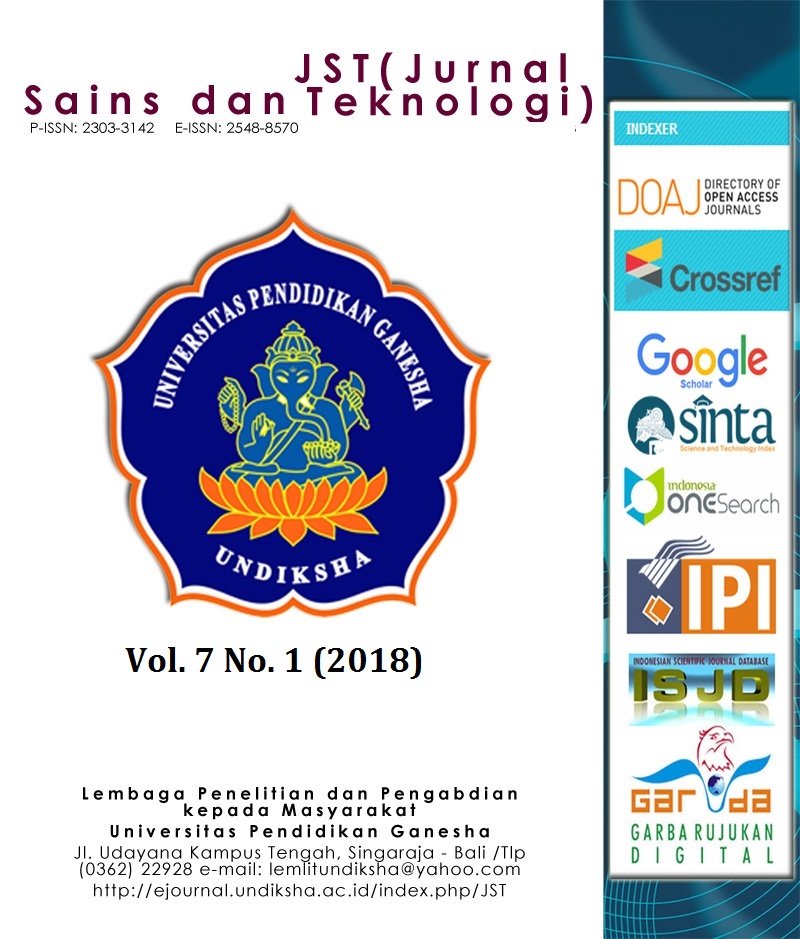Pengembangan Aplikasi Markerless Augmented Reality Legenda Asal Mula Selat Bali
DOI:
https://doi.org/10.23887/jstundiksha.v7i1.8786Abstract
Abstrak— Penelitian ini dilakukan dengan tujuan untuk (1) merancang dan mengimplementasikan aplikasi Markerless Augmented Reality Legenda Asal Mula Selat Bali (2) mengetahui respon pengguna terhadap aplikasi Markerless Augmented Reality Legenda Asal Mula Selat Bali. Sudah saatnya kemajuan teknologi digunakan sebagai sarana untuk kembali membangkitkan kebudayaan Bali khususnya dalam hal cerita rakyat karena pelestarian kebudayaan dapat diupayakan dengan bantuan teknologi. Penelitian ini menggunakan menggunakan proses R&D (Riset and Development) dengan model ADDIE (Analysis Design Development Implementation Evaluate). Model ADDIE terdiri dari 5 tahapan, yaitu Analysis (Analisis), Design (Desain), Development (Pengembangan), Implementation (Implementasi) dan Evaluate (Evaluasi). Hasil akhir penelitian ini berupa sebuah perangkat lunak aplikasi yang mampu dijalankan pada perangkat dengan system operasi android yaitu sebuah aplikasi markerless augmented reality dengan teknik user defined target (UDT) untuk menampilkan animasi 3 dimensi cerita Legenda Asal Mula Selat Bali lengkap dengan suara narasi cerita dalam Bahasa Indonesia dan Bahasa Inggris serta diiringi musik pengiring. Berdasarkan perhitungan yang dilakukan, aplikasi berada dalam kategori sangat baik dalam setiap pengujian. Berdasarkan hasil pengujian, aplikasi ini dapat diterapkan di lingkungan masyarakat agar dapat dijadikan sebagai media untuk memperkenalkan sekaligus melestarikan cerita rakyat Bali. Kata-kata kunci: Cerita Rakyat, Legenda Asal Mula Selat Bali, Markerless Augmented Reality, 3 Dimensi, Android Abstract— This research was conducted in order to (1) to design and implement applications Markerles Augmented Rality Legenda Asal Mula Selat Bali (2) determine the user response to the application of Markerles Augmented Rality Legenda Asal Mula Selat Bali. It is time that technological advances are used as a means to re-awaken the culture of Bali, especially in terms of folklore for the preservation of culture can be built with the help of technology. This study uses using process R & D (Research and Development) with a model ADDIE (Analysis Design Development Implementation Evaluate). ADDIE Model consists of five phases, namely Analysis (Analysis), Design (Design), Development (development), Implementation (Implementation) and Evaluate (Evaluation). The final result of this research is a software application that can run on devices with operating system Android is an application Markerless augmented reality techniques user defined targets (UDT) to display 3-dimensional animation stories Legend Origins Bali Strait complete with voice narration story in English Indonesian and English and accompanied by a musical accompaniment. Based on calculations performed, the application is in the excellent category in each test. Based on test results, this application can be applied in communities in order to serve as a medium to introduce and preserve the Balinese folklore. Keywords: Folklore, Legenda Asal Mula Selat Bali, Markerless Augmented Reality,3 Dimension, AndroidDownloads
Published
2018-07-02
How to Cite
Natha, T. W., Darmawiguna, I. G. M., & Arthana, I. K. R. (2018). Pengembangan Aplikasi Markerless Augmented Reality Legenda Asal Mula Selat Bali. JST (Jurnal Sains Dan Teknologi), 7(1), 90–101. https://doi.org/10.23887/jstundiksha.v7i1.8786
Issue
Section
Articles
License
Authors who publish with the Jurnal Sains dan Teknologi (JST) agree to the following terms:
- Authors retain copyright and grant the journal the right of first publication with the work simultaneously licensed under a Creative Commons Attribution License (CC BY-SA 4.0) that allows others to share the work with an acknowledgment of the work's authorship and initial publication in this journal.
- Authors are able to enter into separate, additional contractual arrangements for the non-exclusive distribution of the journal's published version of the work (e.g., post it to an institutional repository or publish it in a book), with an acknowledgment of its initial publication in this journal.
- Authors are permitted and encouraged to post their work online (e.g., in institutional repositories or on their website) prior to and during the submission process, as it can lead to productive exchanges, as well as earlier and greater citation of published work. (See The Effect of Open Access)
















